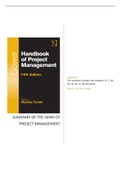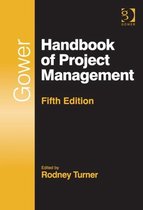Resume
Samenvatting Gower Handbook of Project Management, ISBN: 9781472422965 Projectmanagement methoden en standaarden (MPM-PM-PMMS-22_1)
Établissement
Hogeschool Utrecht (HU)
Een samenvatting van de volgende hoofdstukken van het boek the handbook of project management (fifth edition): 6, 7, 10, 14, 15, 16, 17, 18, 22, 25.
Gemaakt voor het vak projectmanagement methoden en standaarden (PMMS) en Agile en Hybride projectmanagement (AHP) voor de master projectmanagement...
[Montrer plus]
Dernier document publié: 1 année de cela
Livre entier ?
Non
Quels chapitres sont résumés ?
Chapter, 6, 7, 10, 14, 15, 16, 17, 18, 22, 25
Publié le
7 octobre 2022
Fichier mis à jour le
4 avril 2023
Nombre de pages
62
Écrit en
2022/2023
Type
Resume
progressive elaboration
scope creep
defining scope
wbs
pbs
work packages
configuration management
life cy
managing scope and configuration
scope definition chain and errors
scope identification errors
Titre de l’ouvrage: Gower Handbook of Project Management
Auteur(s): Rodney Turner
Édition: 2014 ISBN: 9781472422965 Édition: 5
Resume
Agile en Hybride samenvatting scrum + gower + slides
Resume
Summary of chapter 6 Gower Handbook of Project Management - Agile and Hybrid Project Management
Resume
Summary of chapter 7 'measuring performance' from the Gower Handbook of project management
Tout pour ce livre (13)
Établissement
Hogeschool Utrecht (HU)
Cours
Master projectmanagement
Cours
Projectmanagement methoden en standaarden (MPMPMPMMS22_1)
Tous les documents sur ce sujet (16)
S'abonner
€6,99
Egalement disponible en groupe à partir de €6,99
Garantie de satisfaction à 100%
Disponible immédiatement après paiement
En ligne et en PDF
Tu n'es attaché à rien
Document également disponible en groupe (2)
Samenvatting Gower Handbook of Project Management, ISBN: 9781472422965 Projectmanagement methoden en standaarden (MPM-PM-PMMS-22_1)
€ 44,39
€ 6,99
11 éléments
1. Resume - Samenvatting gower handbook of project management, isbn: 9781472422965 projectmanage...
2. Resume - Chapter 10 'managing scope and configurations' gower handbook of project management, ...
3. Resume - Chapter 14 'managing for stakeholders' gower handbook of project management, isbn: 97...
4. Resume - Chapter 15 'managing the schedule' gower handbook of project management, isbn: 978147...
5. Resume - Chapter 17 'managing resources' gower handbook of project management, isbn: 978147242...
6. Resume - Chapter 18 'managing risk' gower handbook of project management, isbn: 9781472422965
7. Resume - Chapter 22 'project start-up' gower handbook of project management, isbn: 97814724229...
8. Resume - Chapter 25 'project close-out' gower handbook of project management, isbn: 9781472422...
9. Resume - Summary of the chapter 16 'managing cost and earned value' from gower handbook of pr...
10. Resume - Summary of chapter 7 'measuring performance' from the gower handbook of project manag...
11. Resume - Summary of chapter 6 gower handbook of project management - agile and hybrid project...
Montrer plus
Voorbereiding op het vak Projectmanagement Methoden en Standaarden (PMMS) van MPM
€ 62,86
€ 8,99
14 éléments
1. Resume - Samenvatting gower handbook of project management, isbn: 9781472422965 projectmanage...
2. Resume - Chapter 10 'managing scope and configurations' gower handbook of project management, ...
3. Resume - Chapter 14 'managing for stakeholders' gower handbook of project management, isbn: 97...
4. Resume - Chapter 15 'managing the schedule' gower handbook of project management, isbn: 978147...
5. Resume - Chapter 17 'managing resources' gower handbook of project management, isbn: 978147242...
6. Resume - Chapter 18 'managing risk' gower handbook of project management, isbn: 9781472422965
7. Resume - Chapter 22 'project start-up' gower handbook of project management, isbn: 97814724229...
8. Resume - Chapter 25 'project close-out' gower handbook of project management, isbn: 9781472422...
9. Resume - Samenvatting self-study moduel ipma4.0
10. Resume - Samenvatting self-study module prince2
11. Resume - Samenvatting van de pp. sheets voor het vak pmms
12. Resume - Samenvatting van de self-study module pmc
13. Resume - Samenvatting prince2 ® 6de editie - pocket guide, isbn: 9789401805919 projectmanage...
14. Autre - Voorbereiding op het tentamen pmms (projectmanagement methoden en standaarden) voor d...
Montrer plus
Ce document est aussi disponible en plusieurs parties :
Chapter 10 'managing scope and configurations' Gower Handbook of Project Management, ISBN: 9781472422965
Chapter 10 Gower Handbook of Project Management, ISBN: 2965
Aperçu Rapide
Chapter 14 'managing for stakeholders' Gower Handbook of Project Management, ISBN: 9781472422965
Chapter 10 Gower Handbook of Project Management, ISBN: 2965
Aperçu Rapide
Chapter 15 'managing the schedule' Gower Handbook of Project Management, ISBN: 9781472422965
Chapter 10 Gower Handbook of Project Management, ISBN: 2965
Aperçu Rapide
Chapter 17 'managing resources' Gower Handbook of Project Management, ISBN: 9781472422965
Chapter 17 Gower Handbook of Project Management, ISBN: 2965
Aperçu Rapide
Chapter 18 'managing risk' Gower Handbook of Project Management, ISBN: 9781472422965
Chapter 18 Gower Handbook of Project Management, ISBN: 2965
Aperçu Rapide
Chapter 22 'project start-up' Gower Handbook of Project Management, ISBN: 9781472422965
Chapter 22 Gower Handbook of Project Management, ISBN: 2965
Aperçu Rapide
Chapter 25 'project close-out' Gower Handbook of Project Management, ISBN: 9781472422965
Chapter 25 Gower Handbook of Project Management, ISBN: 2965
Aperçu Rapide
Summary of the chapter 16 'managing cost and earned value' from Gower Handbook of project management
Summary of the chapter 16 'managing cost and earned value' from Gower Handbook of project management
Aperçu Rapide
Summary of chapter 7 'measuring performance' from the Gower Handbook of project management
Summary of chapter 7 'measuring performance' from the Gower Handbook of project management
Aperçu Rapide
ABSTRACT





